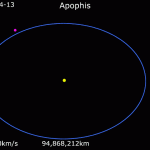
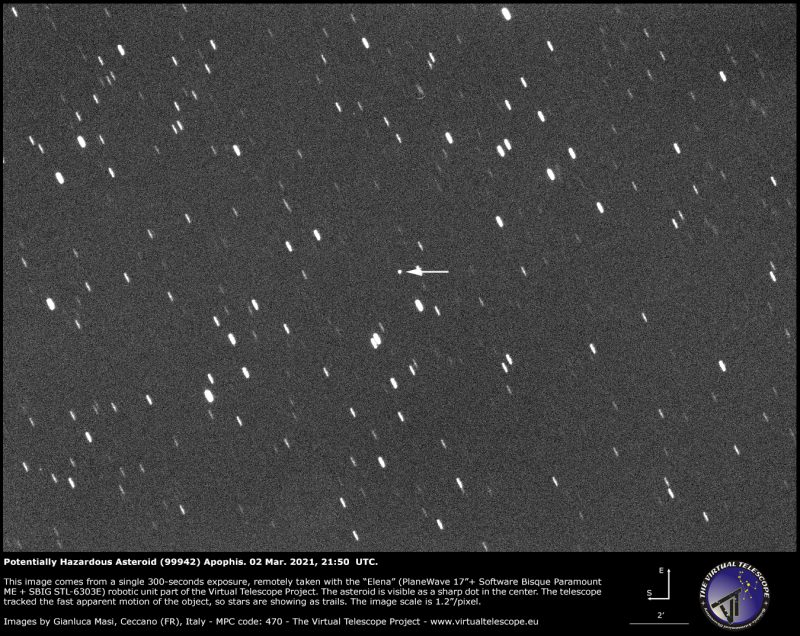
The Virtual Telescope Project, based in Rome, Italy, captured asteroid (99942) Apophis on March 2, 2021. The asteroid shows as a dot – while the stars around it show as streaks – because the telescope was tracking the asteroid’s motion. It is moving through space with respect to Earth at 4.658 km/sec (2.894 miles/sec). Image via Virtual Telescope.
Astronomers have turned their gaze toward asteroid Apophis this week, as it makes its closest sweep past Earth prior to its exceedingly close 2029 pass. It’ll come closest in 2021 on March 5-6, not particularly close this time, but still within range of earthly telescopes and radar. Apophis is a near-Earth asteroid with a relatively large size (nearly 400 meters, or yards, across). It sparked excitement in 2004 when early observations suggested it might strike Earth as it sweeps past in 2029. A 2029 strike was subsequently ruled out, and Apophis is not expected to strike Earth in this century. But this asteroid is a frequent visitor to our region of space, and astronomers want to know more.
NASA’s Goldstone Deep Space Communications Complex in California has had the asteroid on its observing schedule since March 3, 2021 and will continue watching it through March 14. Researchers are also using the Green Bank Telescope in West Virginia to coordinate with Goldstone; using the two telescopes allows the data to be sharper. The International Asteroid Warning Network (IAWN) – which has members in Europe, Asia, and South and North America – is coordinating the 2021 campaign to observe Apophis.
The asteroid will sweep closest to our planet on March 6, 2021, at 01:15 UTC (March 5 on 8:15 p.m. EST; translate UTC to your time). At this 2021 pass, it’ll come within 10,471,577 miles (16,852,369 km). That’s about 44 times the moon’s distance, a very safe distance for this pass.
The Virtual Telescope Project in Rome is offering a free, online viewing session of asteroid Apophis on March 5-6, 2021. The feed will start on March 6 at 00:00 UTC (March 5 at 7 p.m. EST; translate UTC).
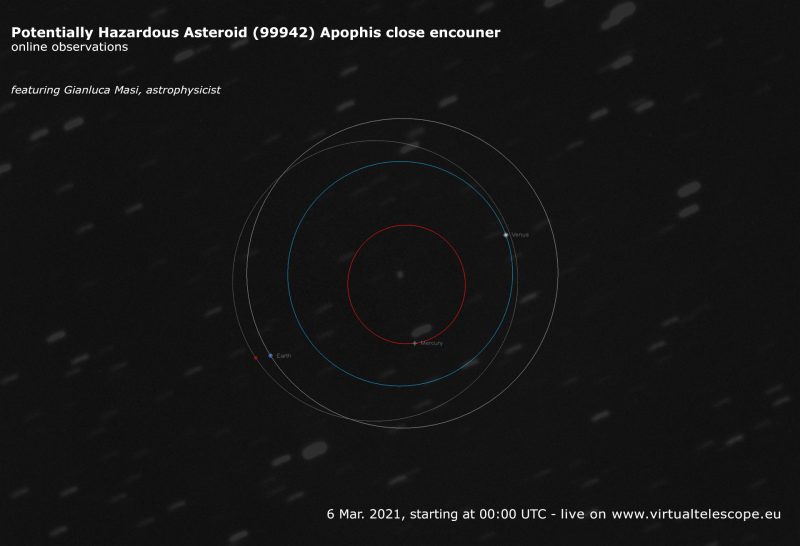
Click here for more information about Virtual Telescope’s live viewing of asteroid Apophis on March 5-6, 2021.

Earlier observations with Goldstone and Arecibo radar observations confirmed that Apophis is elongated in shape. Image via NASA/ JPL.
In addition, astronomers are planning to study asteroid Apophis using NASA’s NEOWISE infrared space telescope in April 2021. This is the same telescope that discovered 2020’s favorite comet, Comet NEOWISE, which has now faded from view.
After the 2029 pass, asteroid Apophis will also make noteworthy passes near Earth in 2036 and again in 2068. As of February 2021, the chances of impact during the 2068 flyby of Apophis are now 1 in 380,000. That’s a 99.99974% chance the asteroid will miss the Earth.
The 2021 observations of Apophis should further improve our knowledge of the asteroid’s shape and spin, and they’ll help reduce uncertainties in the space rock’s orbit caused by Yarkovsky acceleration.
In fact, in some instances, acceleration – a change in an object’s speed and direction through space – can help avoid a collision. This seems to be the case for asteroid Apophis.
Previous calculations (made in 2016) had all but ruled out the probability of an impact in 2068. The chance of an impact was seen in 2016 as vanishingly small, at just 1 in 150,000 odds of impact, or a 99.99933% chance the asteroid would miss the Earth. The more recent observations, first discussed in October 2020 and updated again in early 2021, show a decreasing risk.

Orbit of asteroid Apophis (pink) in contrast to the orbit of Earth (blue). The yellow dot represents the sun. Apophis takes 323.6 days to orbit the sun. Earth takes 365.3 days. Thus this asteroid is a fairly frequent visitor to our region of space. Image via Phoenix7777/ Wikimedia Commons.
It’s a Yarkovsky acceleration of asteroid Apophis – detected by astronomers at the University of Hawaii – that has reduced the impact probability for the 2068 flyby. Dave Tholen and collaborators used the 323-inch (8.2-meter) Subaru Telescope at Maunakea, Hawaii, to make the most recent observations. These astronomers were then able to update the Earth-impact risk from Apophis, including the latest measurements of the Yarkovski effect, which arises from a minuscule push imparted by sunlight.
Visit the Apophis page at the Center for Near Earth Object Studies
The new work by Tholen and colleagues suggests that Apophis – whose estimated diameter is between 1,115 and 1,214 feet (340 to 370 meters) – is drifting more than 500 feet (about 170 meters) per year from its expected position in its orbit.
Tholen – who has been tracking the motion of Apophis in the sky since he and his colleagues discovered it from Kitt Peak National Observatory near Tucson, Arizona, in on June 19, 2004 – commented in the statement:
We have known for some time that an impact with Earth is not possible during the 2029 close approach.
The new observations we obtained with the Subaru telescope earlier this year were good enough to reveal the Yarkovsky acceleration of Apophis, and they show that the asteroid is drifting away from a purely gravitational orbit by about 170 meters [about 500 feet] per year, which is enough to keep the 2068 impact scenario in play.
These observations aren’t easy to obtain and analyze. Factors such as the asteroid’s distance at the time of observation, its composition, its shape and its surface features all affect the outcome.
But astronomers are pushing to understand the orbit of asteroid Apophis because of its close sweeps past our planet in this century and beyond.
Read more about the Yarkovsky effect: Pushing asteroids around with sunlight
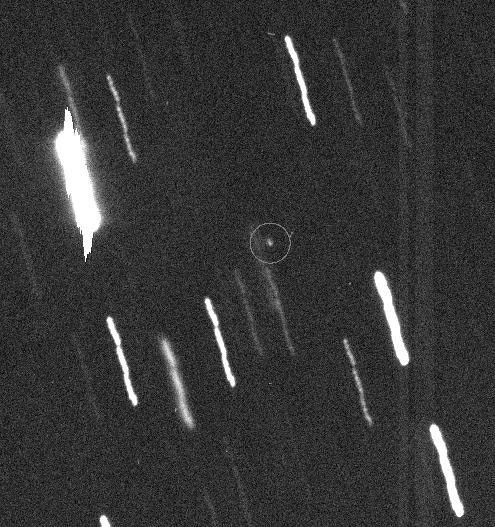
Because of the distance, asteroid 99942 Apophis appears as a small dot in this telescope image. Image via University of Hawaii.
In recent years, astronomers have been able to find and track many tiny asteroids sweeping very near the Earth. For example, on September 24, 2020, asteroid 2020 SW swept even closer to us than our meteorological and television satellites as well as other geostationary satellites, which orbit our planet at some 22,300 miles (35,900 km) from Earth’s surface. Asteroid 2020 SW came within about 7% of the Earth-moon distance. But asteroid 2020 SW is estimated to be only about 14 to 32 feet (about 4.5 to 10 meters) in diameter. That’s very small in contrast to asteroid Apophis.
The 2029 pass of asteroid Apophis. The April 13, 2029 encounter of Apophis with Earth will be extremely close. At its closest in 2029, Apophis will sweep just 23,441 miles (37,725 km) from our planet, or about 10% of the Earth-moon distance. That’s very close for a space rock over 1,115 ft (340 meters) across! Lance Benner of NASA/JPL commented:
This will be the closest approach by something this large currently known. (In 2029) Apophis will be visible to the unaided eye for several hours, and Earth tides will probably change its spin state.
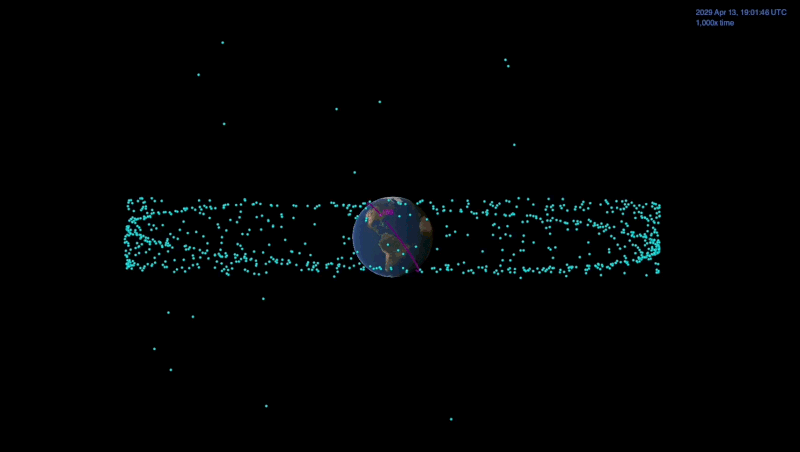
This animation shows the distance between the Apophis asteroid and Earth at the time of the asteroid’s closest approach in 2029. The blue dots are manmade satellites orbiting our planet, and the pink represents the International Space Station. Image via NASA/ JPL-Caltech.
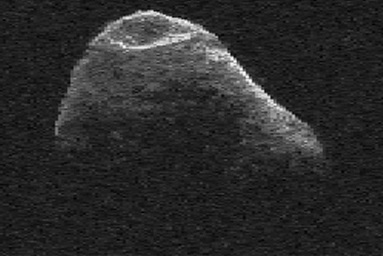
Another radar image of asteroid 99942 Apophis. Image via NASA/ JPL.
Friday, April 13, 2029, will be a showtime for the general public and astronomers alike. Apophis will come so close that it’ll be visible to the unaided eye alone; something that almost never happens with asteroids! According to NASA, Apophis will first become visible in the Southern Hemisphere and will look like a speck of light moving across Australia during this close encounter. It will be over the Atlantic Ocean at its closest approach to Earth. It will move so fast that it crosses the Atlantic in just an hour, and will have crossed the U.S. in the late afternoon/early evening within the next hour. Calculations indicate that Apophis will reach a visual magnitude of 3.1 during this approach, comparable to the stars in the Little Dipper. It is expected to be visible to the unaided eye from some areas of Australia, western Asia, Africa, and Europe.
An asteroid is quite the traveler: While the semi-major axis (the largest diameter of its elongated orbit) of Apophis’ orbit now is shrinking by 170 meters (500 feet) per year, Dave Tholen told EarthSky that this will change:
The 2029 close approach to the Earth will increase the semi-major axis significantly, changing Apophis from an asteroid of the Aten variety to one of the Apollo variety. Average orbital speed will slow down as a result.
So currently, Apophis has a semi-major axis smaller than that of the Earth and occasionally crosses paths with our orbit. This makes it an Aten category asteroid in the Near Earth Objects (NEO) classifications, and means that the asteroid spends the majority of its time inside the Earth’s orbit around the sun. After 2029, it will join the ranks of Apollo objects, which still cross Earth’s orbit but have a semi-major axis larger than the Earth’s. That is, Apophis will then live its majority of time outside Earth’s orbit.
Like many other asteroids, Apophis has been classified as a Potentially Hazardous Asteroid by the International Astronomical Union’s Minor Planet Center.
According to some estimates, an asteroid the size of Apophis can be expected to strike Earth about every 80,000 years.

As a result of the extremely close approach of April 2029, it is expected that perturbations caused by Earth’s gravity will change Apophis’ orbit from the Aten to the Apollo class. Image via NASA/ JPL.
Bottom line: Asteroid Apophis’ sweep past Earth this week will be the closest before its exceedingly close pass in 2029. Astronomers say there is no danger that it will hit Earth this century.
Read more about the Yarkovsky effect: Pushing asteroids around with sunlight
from EarthSky https://ift.tt/34Qicoz


The Virtual Telescope Project, based in Rome, Italy, captured asteroid (99942) Apophis on March 2, 2021. The asteroid shows as a dot – while the stars around it show as streaks – because the telescope was tracking the asteroid’s motion. It is moving through space with respect to Earth at 4.658 km/sec (2.894 miles/sec). Image via Virtual Telescope.
Astronomers have turned their gaze toward asteroid Apophis this week, as it makes its closest sweep past Earth prior to its exceedingly close 2029 pass. It’ll come closest in 2021 on March 5-6, not particularly close this time, but still within range of earthly telescopes and radar. Apophis is a near-Earth asteroid with a relatively large size (nearly 400 meters, or yards, across). It sparked excitement in 2004 when early observations suggested it might strike Earth as it sweeps past in 2029. A 2029 strike was subsequently ruled out, and Apophis is not expected to strike Earth in this century. But this asteroid is a frequent visitor to our region of space, and astronomers want to know more.
NASA’s Goldstone Deep Space Communications Complex in California has had the asteroid on its observing schedule since March 3, 2021 and will continue watching it through March 14. Researchers are also using the Green Bank Telescope in West Virginia to coordinate with Goldstone; using the two telescopes allows the data to be sharper. The International Asteroid Warning Network (IAWN) – which has members in Europe, Asia, and South and North America – is coordinating the 2021 campaign to observe Apophis.
The asteroid will sweep closest to our planet on March 6, 2021, at 01:15 UTC (March 5 on 8:15 p.m. EST; translate UTC to your time). At this 2021 pass, it’ll come within 10,471,577 miles (16,852,369 km). That’s about 44 times the moon’s distance, a very safe distance for this pass.
The Virtual Telescope Project in Rome is offering a free, online viewing session of asteroid Apophis on March 5-6, 2021. The feed will start on March 6 at 00:00 UTC (March 5 at 7 p.m. EST; translate UTC).

Click here for more information about Virtual Telescope’s live viewing of asteroid Apophis on March 5-6, 2021.

Earlier observations with Goldstone and Arecibo radar observations confirmed that Apophis is elongated in shape. Image via NASA/ JPL.
In addition, astronomers are planning to study asteroid Apophis using NASA’s NEOWISE infrared space telescope in April 2021. This is the same telescope that discovered 2020’s favorite comet, Comet NEOWISE, which has now faded from view.
After the 2029 pass, asteroid Apophis will also make noteworthy passes near Earth in 2036 and again in 2068. As of February 2021, the chances of impact during the 2068 flyby of Apophis are now 1 in 380,000. That’s a 99.99974% chance the asteroid will miss the Earth.
The 2021 observations of Apophis should further improve our knowledge of the asteroid’s shape and spin, and they’ll help reduce uncertainties in the space rock’s orbit caused by Yarkovsky acceleration.
In fact, in some instances, acceleration – a change in an object’s speed and direction through space – can help avoid a collision. This seems to be the case for asteroid Apophis.
Previous calculations (made in 2016) had all but ruled out the probability of an impact in 2068. The chance of an impact was seen in 2016 as vanishingly small, at just 1 in 150,000 odds of impact, or a 99.99933% chance the asteroid would miss the Earth. The more recent observations, first discussed in October 2020 and updated again in early 2021, show a decreasing risk.

Orbit of asteroid Apophis (pink) in contrast to the orbit of Earth (blue). The yellow dot represents the sun. Apophis takes 323.6 days to orbit the sun. Earth takes 365.3 days. Thus this asteroid is a fairly frequent visitor to our region of space. Image via Phoenix7777/ Wikimedia Commons.
It’s a Yarkovsky acceleration of asteroid Apophis – detected by astronomers at the University of Hawaii – that has reduced the impact probability for the 2068 flyby. Dave Tholen and collaborators used the 323-inch (8.2-meter) Subaru Telescope at Maunakea, Hawaii, to make the most recent observations. These astronomers were then able to update the Earth-impact risk from Apophis, including the latest measurements of the Yarkovski effect, which arises from a minuscule push imparted by sunlight.
Visit the Apophis page at the Center for Near Earth Object Studies
The new work by Tholen and colleagues suggests that Apophis – whose estimated diameter is between 1,115 and 1,214 feet (340 to 370 meters) – is drifting more than 500 feet (about 170 meters) per year from its expected position in its orbit.
Tholen – who has been tracking the motion of Apophis in the sky since he and his colleagues discovered it from Kitt Peak National Observatory near Tucson, Arizona, in on June 19, 2004 – commented in the statement:
We have known for some time that an impact with Earth is not possible during the 2029 close approach.
The new observations we obtained with the Subaru telescope earlier this year were good enough to reveal the Yarkovsky acceleration of Apophis, and they show that the asteroid is drifting away from a purely gravitational orbit by about 170 meters [about 500 feet] per year, which is enough to keep the 2068 impact scenario in play.
These observations aren’t easy to obtain and analyze. Factors such as the asteroid’s distance at the time of observation, its composition, its shape and its surface features all affect the outcome.
But astronomers are pushing to understand the orbit of asteroid Apophis because of its close sweeps past our planet in this century and beyond.
Read more about the Yarkovsky effect: Pushing asteroids around with sunlight

Because of the distance, asteroid 99942 Apophis appears as a small dot in this telescope image. Image via University of Hawaii.
In recent years, astronomers have been able to find and track many tiny asteroids sweeping very near the Earth. For example, on September 24, 2020, asteroid 2020 SW swept even closer to us than our meteorological and television satellites as well as other geostationary satellites, which orbit our planet at some 22,300 miles (35,900 km) from Earth’s surface. Asteroid 2020 SW came within about 7% of the Earth-moon distance. But asteroid 2020 SW is estimated to be only about 14 to 32 feet (about 4.5 to 10 meters) in diameter. That’s very small in contrast to asteroid Apophis.
The 2029 pass of asteroid Apophis. The April 13, 2029 encounter of Apophis with Earth will be extremely close. At its closest in 2029, Apophis will sweep just 23,441 miles (37,725 km) from our planet, or about 10% of the Earth-moon distance. That’s very close for a space rock over 1,115 ft (340 meters) across! Lance Benner of NASA/JPL commented:
This will be the closest approach by something this large currently known. (In 2029) Apophis will be visible to the unaided eye for several hours, and Earth tides will probably change its spin state.

This animation shows the distance between the Apophis asteroid and Earth at the time of the asteroid’s closest approach in 2029. The blue dots are manmade satellites orbiting our planet, and the pink represents the International Space Station. Image via NASA/ JPL-Caltech.

Another radar image of asteroid 99942 Apophis. Image via NASA/ JPL.
Friday, April 13, 2029, will be a showtime for the general public and astronomers alike. Apophis will come so close that it’ll be visible to the unaided eye alone; something that almost never happens with asteroids! According to NASA, Apophis will first become visible in the Southern Hemisphere and will look like a speck of light moving across Australia during this close encounter. It will be over the Atlantic Ocean at its closest approach to Earth. It will move so fast that it crosses the Atlantic in just an hour, and will have crossed the U.S. in the late afternoon/early evening within the next hour. Calculations indicate that Apophis will reach a visual magnitude of 3.1 during this approach, comparable to the stars in the Little Dipper. It is expected to be visible to the unaided eye from some areas of Australia, western Asia, Africa, and Europe.
An asteroid is quite the traveler: While the semi-major axis (the largest diameter of its elongated orbit) of Apophis’ orbit now is shrinking by 170 meters (500 feet) per year, Dave Tholen told EarthSky that this will change:
The 2029 close approach to the Earth will increase the semi-major axis significantly, changing Apophis from an asteroid of the Aten variety to one of the Apollo variety. Average orbital speed will slow down as a result.
So currently, Apophis has a semi-major axis smaller than that of the Earth and occasionally crosses paths with our orbit. This makes it an Aten category asteroid in the Near Earth Objects (NEO) classifications, and means that the asteroid spends the majority of its time inside the Earth’s orbit around the sun. After 2029, it will join the ranks of Apollo objects, which still cross Earth’s orbit but have a semi-major axis larger than the Earth’s. That is, Apophis will then live its majority of time outside Earth’s orbit.
Like many other asteroids, Apophis has been classified as a Potentially Hazardous Asteroid by the International Astronomical Union’s Minor Planet Center.
According to some estimates, an asteroid the size of Apophis can be expected to strike Earth about every 80,000 years.

As a result of the extremely close approach of April 2029, it is expected that perturbations caused by Earth’s gravity will change Apophis’ orbit from the Aten to the Apollo class. Image via NASA/ JPL.
Bottom line: Asteroid Apophis’ sweep past Earth this week will be the closest before its exceedingly close pass in 2029. Astronomers say there is no danger that it will hit Earth this century.
Read more about the Yarkovsky effect: Pushing asteroids around with sunlight
from EarthSky https://ift.tt/34Qicoz

Aucun commentaire:
Enregistrer un commentaire